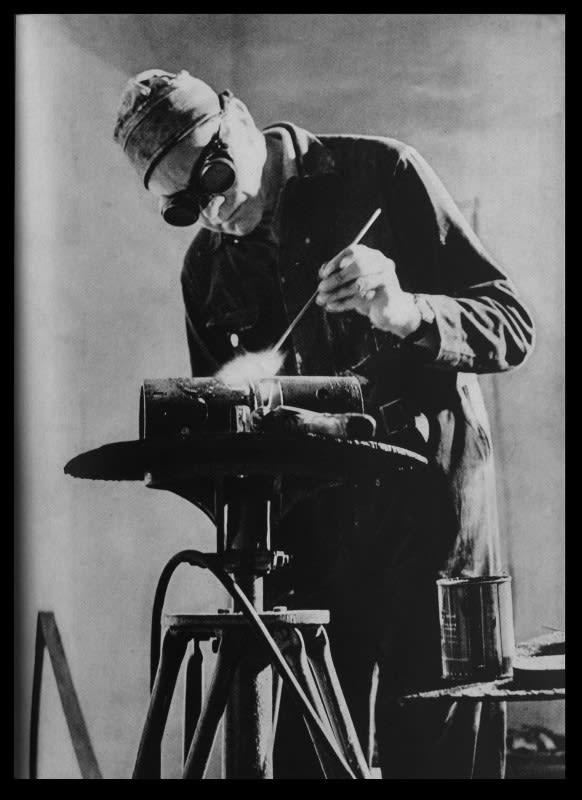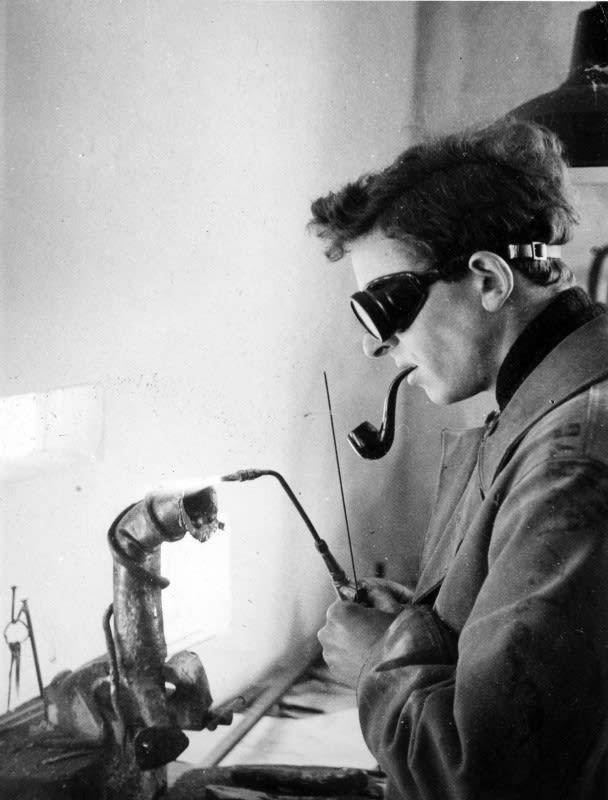
SCULPTORS' MATERIALS: IRON
Welcome to #7 in our series of Sculptors' Materials. We hope you enjoy it!
Iron is a material with a rich history and is so important that without its discovery; the world as we know it would look vastly different.
Some of the earliest examples of iron dates back to 3500 BC where beads of meteoric iron were worked into objects and weapons. Meteoric iron was the only naturally occurring source of iron readily available, as iron reacts readily with oxygen to form ‘iron ore’ and, as there is no oxygen in space, meteors deliver the material to earth in a way that allowed humans to use the material before having the tools themselves to extract iron from it’s ‘ore’. An ore is a naturally occurring material in which valuable minerals can be extracted.
One of the earliest examples of iron forging comes from a surviving gold handled dagger, found in the tomb of Egyptian Pharaoh; Tutankhamun. The dagger’s blade, made from iron, dates back to 1327 BC and by some miracle, still remains in near perfect condition.
Iron is the 4th most common material found in the Earth’s crust but, as it reacts readily with oxygen causing iron oxide ores. RUST is a common iron oxide and working to prevent this is a constant struggle in structure maintenance.

The single largest uses of iron is to make steel as iron alone is too soft for the strength required for structural value. The main difference between iron and steel is the amount of carbon each metal contains.
Anything with a carbon content of above 2% is cast iron. Anything higher makes it the material less ductile and more brittle. Cast iron is not suitable for structural use, its use in the mid 19th Century in some bridges let to their collapse. These were later replaced with wrought iron, which contains less than 0.8% of carbon, meaning it is more ductile, allowing it to bend under loads without breaking.
The tallest 'wrought' iron structure in the world is the Eiffel Tower and to prevent rust, every 7 years 60 tonnes of paint is applied to the Eiffel Tower, meaning it has changed colour over the years too. Did you know the tower was initially red? It has changed colour a few times until a special Eiffel Tower paint was established in 1968.
The world's first ironbridge open in Shropshire in 1781 over the River Severn, and was hailed as a pioneering advancement in British iron works, design engineering. The bridge was so successful that it gave its name to the spectacular wooded valley which surrounds it, now recognised as the Ironbridge Gorge World Heritage Site.
It was near by in the town of Coalbrookdale, that Abraham Darby pioneered the smelting of iron using coke, a process which is hailed as the catalyst to Britain's Industrial revolution.

Iron too is a material which has inspired generations of artists, either using the material itself within their craft or as an inspiration. Acclaimed painter, Sir Joseph Wright of Derby's An Iron Forge, painted in 1772, is not only hailed as a perfect example of his light studies, but also as an important source which documents the realities of iron-founders and their process.
Sculptors too have enjoyed the ductile nature of iron. Pangolin London artist Geoffrey Clarke, after undertaking a welding course in 1951 at the British Oxygen Company, alongside fellow artist Lynn Chadwick and Reg Butler, used iron in vast quantities in his early works, producing his own visual language now iconic within Post-War British art.
Lynn Chadwick too used his skills learned at the course to create the inner frames of his now universally recognised watchers and beasts before they were cast in bronze.
 |
 |
| Lynn Chadwick in his Studio | Geoffrey Clarke in his Studio |
Artist Jeff Lowe,(part of the group of sculptors known as the 'New Generation') too has experimented in cast iron sculptures.
A more 21st Century use of the material can be seen in Pangolin London's third sculptor in residence, Zachary Eastwood Bloom, who for his solo exhibition Divine Principles in 2017, cast the God of War, Mars, in iron; symbolic of not only the solar system's red planet but of the material used centuries before in weapon production which revolutionised the art of war itself.
A FEW FACTS ABOUT IRON
- The element symbol for iron found on the periodic table is ‘Fe’, which comes from the Latin word for iron, "ferrum.
- The Iron Pillar of Delhi, India, is a 1600 year old structure which stands 7.3 meters high. The pillar is said to possess special powers as the iron has never rusted!
- The Eiffel Tower in Paris is the largest structure made from Wrought Iron in the world.
- One of the world's most famous iron buildings, The Capitol, in Washington, DC; has a dome made of cast iron.
- Iron constitutes 5 percent by weight of the Earth's crust, and it is the fourth most abundant element after oxygen, silicon, and aluminium.
- The word "wrought" is an archaic past participle of the verb "to work," and so "wrought iron" literally means "worked iron"
Images: Zachary Eastwood-Bloom, Orphan of Apollo/Mars,2017, Iron; Tutankhamun Dagger. Image courtesy of The British Museum.
Joesph Wright of Derby, An Iron Forge, 1772, Acrylic on Canvas. Image courtesy of Tate. Bruce Beasley, Aeolis 5, 2018, Cast Iron; Jeff Lowe, Taking Shape No.8, 2013, Cast Iron, Unique ; Geoffrey Clarke, Effigy, 1951, Welded Iron, Unique
